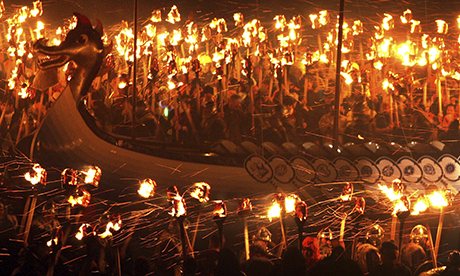
Up Helly Aa, Lerwick
While most of us spend January dragging our heels beneath a metaphorical (and often literal) grey cloud of gloom, in Lerwick, the capital of Shetland, in Scotland, the locals set fire to things instead. Up Helly Aa, which takes place at the start of each year, is Europe's biggest fire festival. The event is a visual feast that makes Guy Fawkes Night seem tame by comparison.
On the last Tuesday of January (in 2014 it takes place on 28 January) hundreds of men don their finest Viking attire, light torches and march through the streets, watched by visitors who travel from around the world to witness the procession, which culminates with the dramatic burning of a galley ship. But despite the ominous presence of hundreds of Vikings, Up Helly Aa is not as ancient a tradition as you might think…
The festival emerged out of raucous end-of-year revelry that used to occur in Lerwick over Christmas. Reports from 1824 describe "shouting, bawling, fiddling, fifeing, drinking, fighting." In other words, all the necessary trappings of a 19th-century shindig. The Viking theme itself, however, was not a part of the celebrations until towards the end of the 19th century when there was a revival of Nordic traditions led by a group of intellectuals who arrived at the Up Helly Aa name and shunted the event into January. Since then it has only been cancelled three times; for the death of Queen Victoria and during the first and second world wars.
The procession starts with a signal rocket that is launched over Lerwick town hall. Then torches are lit and a band begins to play. Those who take part in the procession are named "Guizers", which refers to the disguises the men wear. Unfortunately, despite other Up Helly Aa festivals, such as the one in Northmavine, welcoming women as guizers, in Lerwick it is still only the men who are allowed to take part.
The mascot of the event is the Guizer Jarl, who leads the guizers through the streets with an axe and raven-winged helmet. Becoming a Jarl is a rare privilege; they are chosen from a committee on which you need to be a member of for 15 years.
Once the procession reaches the galley ship, the guizers form a fiery circle around it, singing the traditional song "The Norseman's Home" before tossing their torches on board, setting the ship ablaze. At this point your thoughts should probably be with the shipbuilders – who take four months to construct the vessel – but that's when the real party begins. The guizers visit a dozen halls around the town in which they perform special "acts" that usually take the form of comedy sketches mocking local events or celebrities. The subsequent all-nighter is such a head banger that the following day is a public holiday, giving the islanders a chance to recover. Of course, being in the sub-Arctic means it can be incredibly cold during the festival. But, in true Viking style: "There will be no postponement for weather."
• 28 January 2014, Lerwick, Shetland; free but tickets required for the halls (adults £30, family ticket for four £100), uphellyaa.org
Customs made: three more unusual January UK get-togethers
The Whittlesea Straw Bear festival
If Cousin Itt from the Addams Family (he's the one completely covered in long blond hair) had a distant cousin, then it would probably be the Straw Bear. On the second weekend of January a man is dressed entirely in straw before dancing through the streets of Whittlesea in Cambridgeshire to traditional music. Festivities for the folk farming festival go on for the whole weekend, with ceilidhs and barn dances in the evening. And in keeping with folk tradition, on Sunday the bear costume is ceremonially burned.
• 10-12 January, daytime events free, evening events £9, strawbear.org.uk
The Haxey Hood
As pub crawls go, the Haxey Hood is probably one of the rowdier ones. Each year the parish in north Lincolnshire takes part in a 14th-century tradition that involves chasing a leather tube until it ends up at one of four local pubs, where it remains until the following year. Although it is a bit of a scrum, the game is supervised by "boggins", who endeavour to keep everyone safe. It's basically like rugby meets quidditch, and for once, nothing gets set on fire at the end of the day.
• 6 January 2014, Haxey, free, wheewall.com
The Chepstow Wassail Mari
Wassailing is an old English tradition of blessing apple trees in the hope of getting a good harvest. It's fun: everyone takes it in turns to drink from a bowl of cider, before holding the bowl up and shouting "Wassail". Events are held around the country, but in Chepstow it's a larger event combined with the Welsh Mari Lywd traditions. There are strange costumes, an abundance of morris dancing and a meeting of the English and Welsh in the middle of the Old Iron Bridge over the river Wye. Come for the cider, stay for the capers.
• 18 January 2014, Chepstow, free, chepstowwassailmari.co.uk

